The OCZ Vector 180 (240GB, 480GB & 960GB) SSD Review
by Kristian Vättö on March 24, 2015 2:00 PM EST- Posted in
- Storage
- SSDs
- OCZ
- Barefoot 3
- Vector 180
Sequential Read Performance
Our sequential tests are conducted in the same manner as our random IO tests. Each queue depth is tested for three minutes without any idle time in between the tests and the IOs are 4K aligned similar to what you would experience in a typical desktop OS.
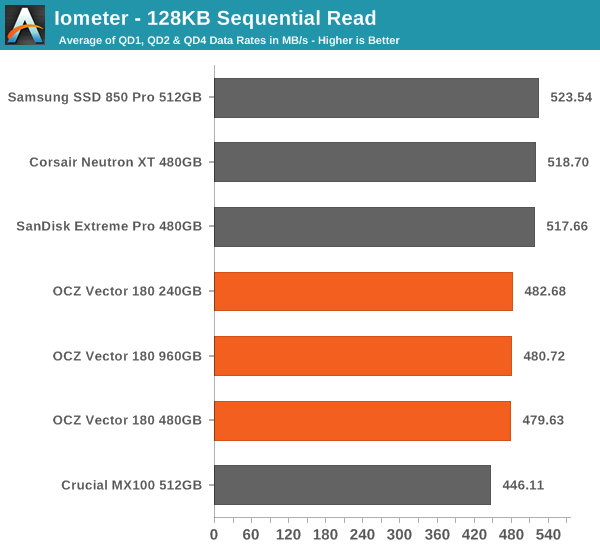
Sequential read performance is decent, but it leaves a bit to be desired to match the other high-end SSDs.
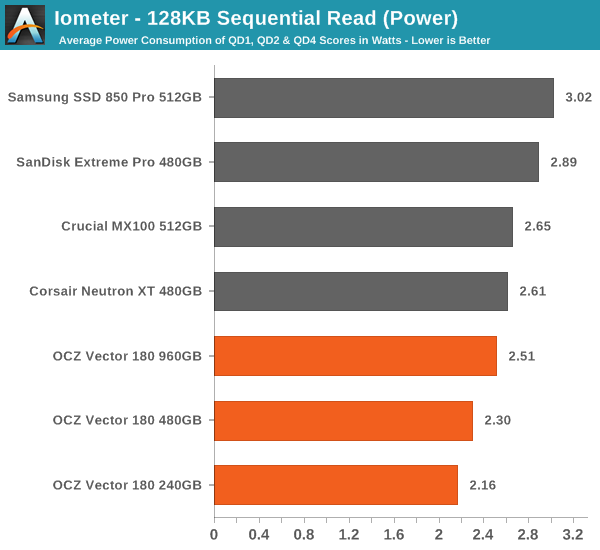
Fortunately the power characteristics are still very good despite the slight lack of performance.
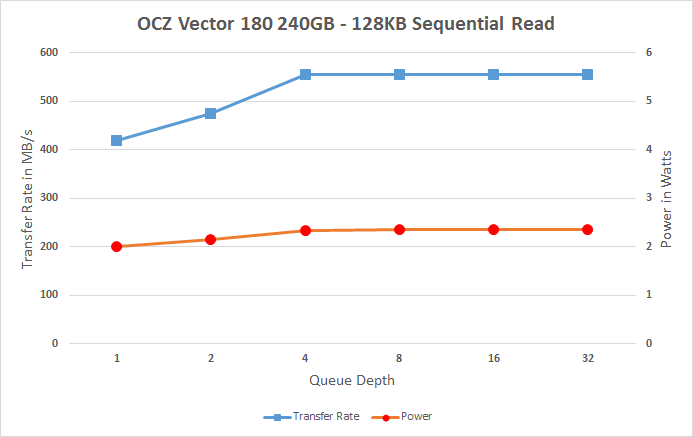 |
|||||||||
The performance at queue depths of 1 and 2 (i.e. the most common ones) leaves room for improvement, but practically every drive is maxing out SATA 6Gbps at QD4 and higher.
Sequential Write Performance
Sequential write testing differs from random testing in the sense that the LBA span is not limited. That's because sequential IOs don't fragment the drive, so the performance will be at its peak regardless.
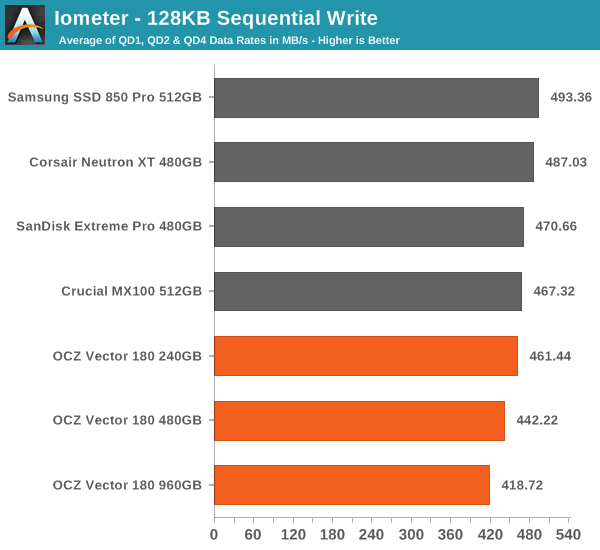
The Vector 180 doesn't do any better in sequential writes and especially the 960GB model is surprisingly slow. It's quite evident that the Barefoot 3 was never designed with such a large capacity in mind as there is clearly some performance loss due to additional LBA tracking from extra NAND.
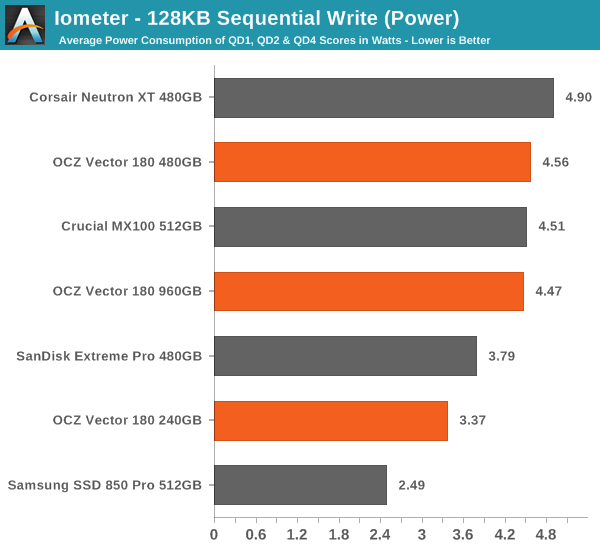
This time the power consumption isn't too good either.
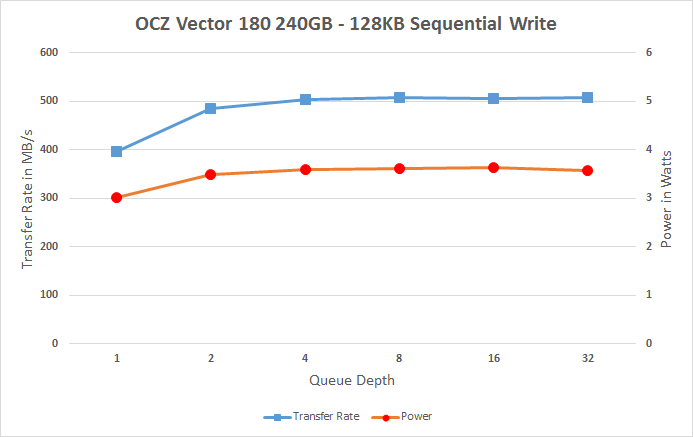 |
|||||||||
While the performance scales pretty nicely, the Vector 180 seems to hit a wall at 500MB/s (450MB/s for the 960GB model). That's pretty far from the 530MB/s that OCZ rates the sequential write at.










89 Comments
View All Comments
nils_ - Wednesday, March 25, 2015 - link
I distinctly remember that when I replaced a SSD in my workstation the Acronis tool, instead of copying my data from the source SSD to the new SSD copied the data to another, unrelated HDD in the system, happily overwriting the Linux partitions stored thereon... I had to unplug everything from the mainboard safe for the old and new SSD to make sure that it doesn't destroy any more of my data.MikeMurphy - Wednesday, March 25, 2015 - link
Macrium Reflect is free and wonderful to use.mapesdhs - Wednesday, March 25, 2015 - link
Yep, MR is what I use, it works very well and has a good interface.
Ian.
JonnyDough - Tuesday, March 31, 2015 - link
Thirded. It works wonderfully.The_Assimilator - Tuesday, March 24, 2015 - link
OCZ is still beating that Barefoot 3 dead horse for all it's worth. No wonder they went bankrupt. If you don't innovate, you die.ocztosh - Tuesday, March 24, 2015 - link
Hello The_Assimilator. Thanks for your comments. Innovation is definitely a key area of focus for us on both the client and enterprise sides of our SSD business. We currently have a lot of resources put on next generation controllers and have been working hard on client SSDs leveraging the latest Toshiba NAND flash, which includes TLC. While some of these products are on the horizon it was natural for us to update our Vector Series with A19 NAND flash, and rather than just make a NAND change we wanted to add new features not normally found in our client class products like power fail management plus (PFM+) to further improve reliability in applications that blur the line between enthusiast and workstation.It is true that Barefoot 3 has, and continues to be, a very strong platform for us as we have shipped so many drives based on this in-house controller, and it has been so solid that we have not had to rev silicon a single time. We will continue to push to innovate when it comes to SSD performance, features and cost and are committed to delivering more value for all our customers. Thanks again for your feedback.
Minion4Hire - Tuesday, March 24, 2015 - link
The bigger problem is that the SSD market has stagnated. When their weren't major players (like Samsung) the little guy could cobble something together and make a decent living filling what was a niche market. Now SSDs are mainstream, and through volume alone the big guys can overpower the little guys, let alone R&D, etc. Until the market shifts away from SATA there's no room for niche innovation or clever advances. It's all down to margins right now.Samus - Tuesday, March 24, 2015 - link
You do realize the two best-selling controllers are Marvell and Sandforce, and both are older than Barefoot 3. The SF2281 is 3+ years old and still ships in a variety of Mushkin, ADATA, Intel, etc SSD's.Barefoot 3 is thoroughly modern, but it does lack some power saving and drive encryption features. I don't think it makes sense for OCZ to update it when PCIe is around the corner and will require a new controller since a bridge will be expensive and not much faster.
Aside from that, Barefoot 3 is incredibly innovative. I consider it the best controller available aside from Intel's 3rd gen controller (equally as old) and Samsung's MEX. ASMedia is still a little inconsistent and featureless, Marvell has an aging indirection table implementation that yields average performance, Phison is clearly entry-level with relatively low performance and consistency, Silicon Motion and Fusion-IO are power hungry, have quirks with certain NAND varieties and are not cost competitive.
Guspaz - Tuesday, March 24, 2015 - link
"There's an old saying in Tennessee - I know it's in Texas, probably in Tennessee - that says, fool me once, shame on - shame on you. Fool me - you can't get fooled again."Yeah, George, I'm not planning on getting fooled by OCZ again.
blue_urban_sky - Tuesday, March 24, 2015 - link
Is that the saying from Tennessee where they cant't remember the proper saying?